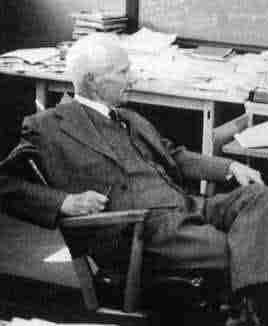
Robert E. Lee Moore's status in the histoy and education of mathematics in the United states is very important. At one time, his method of teaching was thought to be the very best. In 1929 he was colloquium speaker at the AMS. In 1937 & 1938, he was President of the American Mathematical Society. Moore was an editor of the Colloquium Publications from 1929 to 1936, being editor-in-chief from 1930 to 1933. Moore taught at the University Texas-Austin until he was 86 years old, and he wished to carry on teaching but the University authorities forced him to retire. In the picture below he is aged 87 and still in his office in Austin, Texas.
The Mathematics-Physics Hall at UT-Austin was named after him and when he died, there was a laudatory article in the Math Monthly, a publication of the Mathematical Association of America. However, many preferred to hide his low side so as not to tarnish his memory. To ignore his staure as a proponent of scientific racism. For African Americans passing through Mathematics at Texas, there was only a tarnished memory and I hope to tell what is partially known of that story.
R. L. Moore (1882-1974)
racist mathematician
unveiled

There were many racist mathematicians in the history of mathematics in the United States. What many Black mathematics students experienced in contact with the racists, is similar, if not in degree, to those below.
1. Walker E. Hunt, Ph.D. from the University of Texas-Austin: "I also wanted to take Robert E.Lee Moore's famous, Foundations of Point-Set Topology. However, that was not to be. The reason, I was black! His words were, 'you are welcome to take my course but you start with a C and can only go down from there.'"
2. Raymond L. Johnson, Ph.D. from Rice University, ex-University of Texas-Austin undergraduate: "The image of R. L. Moore in my eyes, however, is that of a mathematician who went to a topology lecture given by a student of R. H. Bing. Bing was (a famous Topologist, and a) student of Moore. The speaker was what mathematicians refer to as Moore's mathematical grandson. When Moore discovered that the student was black, he walked out of the lecture. (Parenthetically, let me say one more good thing about Bing. He was a topologist of world-renowned stature and Texas desperately wanted to attract him back from Wisconsin. Word was that Bing had said he would never return to Texas while Moore was there. Moore died and a year or so later Bing returned to Texas. I have a very different image of R. H. Bing.
3. Vivienne Mayes-Malone, Ph.D. from the University of Texas-Austin: She could not enroll in professor R.L. Moore class, as he explicitly stated that he did not teach Blacks. Overlooking all this, another of her professors, complaining against the civil rights demonstrations, said to her: "If all those out there were like you, hard-working and studious, we wouldn't have any problems." Her reply: "If it hadn't been for those hell-raisers out there, you wouldn't even know me."
4. Scott Williams, Topologist: I know and have had excellent relations with many ex-students of Moore such as Ben Fitzpatrick, and one ex-Moore student, Mary Ellen Rudin, has been extremely helpful to my career. However, the annual Point-Set Topology conference was always held in the spring and most often in the south. In 1976 on my first visit to the conference held at one university, I was greeted by two ex-Moore students who said, "You are lucky he is dead [Moore died in 1974]. Otherwise, you would not be here."
5. Folks fail to realize the power R. L. Moore held at Texas. As Leonard Gillman reports, There was a rule at the university that after retiring at age 70, a professor could continue to teach half time year to year upon the recommendation of the departmental "Budget Council" that he was still "fit to teach". In 52 Moore was 70 but he taught until 1969, he been reappointed 17 times. Moore's graduate students had private offices while most faculty were doubled up.
Finally, to Moore and other racist mathematicians. We remember, and persevere despite of, your contribution.
References:
1. William Hunt page
2. Raymond Johnson page
3. Vivienne Mayes-Malone page
4. R.L. Moore page
5. Leonard Gillman TopCom interview in Topology Atlas. part 1 - part 2
6 L Whyburn, "Letters from the R L Moore papers", Proceedings of the 1977 Topology Conference I, Topology Proc. 2 (1) (1977), 323-338.
7. R L Wilder, "Robert Lee Moore, 1882-1974", Bull. Amer. Math. Soc. 82 (3) (1976), 417-427.
8. R L Wilder, Erratum: "Robert Lee Moore, 1882-1974", Bull. Amer. Math. Soc. 83 (3) (1977), 415.
9. R L Wilder, The Mathematical Work of R L Moore: its background, nature and influence, Archive for History of Exact Science 26 (1) (1982), 73-97.
10. Notices AMS1: http://www.ams.org/notices/199706/comm-yorke.pdf
11. Notices AMS2: http://www.ams.org/notices/199603/parshall.pdf
Perhaps because they were too smart, Moore did not seem to infect his students with racism. Indeed, his first Ph.D. student, John Kline was the advisor of Dudley Weldon Woodard and William Schieffelin Claytor , the second and third African Americans to earn a Ph.D. in Mathematics. I do not name the rest as I do not wish to confuse the sins of the teacher with the students. I can personally verify that the beliefs of my professor had nothing to do with the mathematics I sought to learn.
An important links
2. Reform and Tradition in Mathematics Education: Example of R. L. Moore
3. The Beginning of Topology in the United States and the Moore School by F.B. Jones
4. April 1999 R. L. Moore conference
5. The Math Geneology Project
Return to Special Articles
![]()
These web pages are brought to you by
The Mathematics Department of
The State University of New York at Buffalo.
created and maintained by
Dr. Scott W. Williams
Professor of Mathematics
![]() 5/28/99
5/28/99